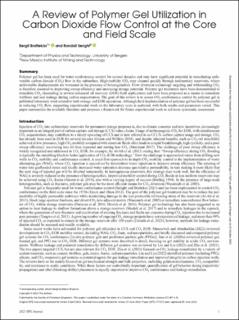A Review of Polymer Gel Utilization in Carbon Dioxide Flow Control at the Core and Field Scale
Journal article, Peer reviewed
Published version

Åpne
Permanent lenke
https://hdl.handle.net/11250/3097819Utgivelsesdato
2023Metadata
Vis full innførselSamlinger
Sammendrag
Polymer gel has been used for water conformance control for several decades and may have significant potential in remediating unfavorable carbon dioxide (CO2) flow in the subsurface. High-mobility CO2 may channel quickly through sedimentary reservoirs, where unfavorable displacements are worsened in the presence of heterogeneities. Flow diversion technology targeting and withstanding CO2 is therefore essential to improving sweep efficiency and increasing storage potential. Polymer gel treatments have been demonstrated to remediate CO2 channeling in several enhanced oil recovery (EOR) field applications and have been proposed as a means to remediate wellbore and seal leakage during carbon sequestration. The goal of this review is to assess CO2 conformance control by polymer gel in published laboratory work related to both storage and EOR operations. Although field implementation of polymer gel has been successful in reducing CO2 flow, supporting experimental work on the laboratory scale is scattered, with both results and parameters varied. This paper summarizes the available literature and proposes a framework for future experimental work to aid more systematic assessment.
